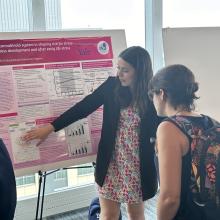Synthetic developmental biology
Harry McNamara's lab investigates multicellular self-organization. During embryonic development, cells communicate with each other to build the complex patterns of gene expression and tissue structures required to make an organism. Remarkably, stem cells grown in vitro can build embryo-like structures all on their own – even without an externally provided 'blueprint' of instructions. Understanding how developmental self-organization arises from fundamental interactions between cells is essential to decoding how the brain builds itself. A better understanding of neural self-organization may also shed light on the specific developmental innovations which make the human brain evolutionarily distinct.
The research group uses stem cell models (organoids, embryo-models, 'stembryos') as laboratories to decode and control developmental self-organization. They use synthetic biology to program stem cells with genetic circuits that can read and write biological signals. This toolkit allows them to identify which signals predict cell fates during self-organization and test theoretical models through perturbation. Their long-term goal is for 'synthetic developmental biology' to become a predictive science which links basic cell biology to emergent multicellular developmental programs.
Methods
Topics
Biography
McNamara joined Yale in January 2025 as an Assistant Professor in Molecular, Cellular, and Developmental Biology and as an Investigator in the Wu Tsai Institute. Previously, he was an independent Lewis-Sigler Scholar at Princeton. He received his PhD in Physics from Harvard, an MSc in Bioengineering from Trinity College Dublin, an MPhil in Nanotechnology from the University of Cambridge, and his BA from Yale (Branford College). Outside of the lab, he enjoys a good travel adventure and a backyard walk with his cat.



